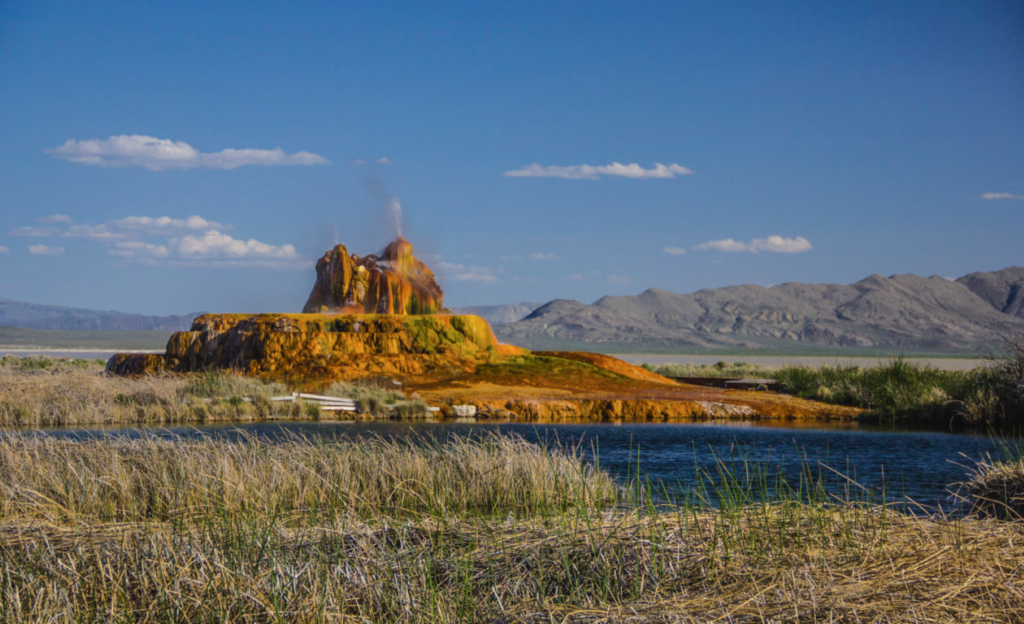Burning Man’s 2016 purchase of Fly Ranch for $6.5 million was part of a contentious broader mission to expand its culture globally.
Anyone who’s visited Fly Ranch can understand why the Burning Man Project might be reluctant to part ways with the picturesque slice of northern Nevada.
Piping hot water flows steadily from Fly Geyser, a bulbous mound of red and green-streaked mineral deposits toward the property’s northern border. It collects in a terrace of shallow rock formations below, spilling from each one into the next as strands of white algae wave like mermaid hair from the bottom.
The premises also include a sliver of the Hualapai Playa three miles to the south, plus an adjacent parcel surrounded by the valley’s flat and featureless expanse on all four sides. Fly Ranch’s flora and fauna transform greatly over a trip from one end to the other.
This five-square-mile property is a 20-minute drive down highway 34 from the 12 Mile Playa Access entrance to the Black Rock Desert — the same one that leads attendees to and from the Burning Man Project’s annual namesake arts event. On paper, Fly Ranch serves as a makerspace for artists in the burner community as well as a setting for the 501(c)(3) nonprofit’s numerous sustainability initiatives.

Right now, though, when the Burning Man Project purportedly faces an existential crisis, many longtime burners would prefer that it refocus its core mission. The organization has been forced to lay off staff and double its year-end fundraising goal. Holding onto projects intended to spread burner culture beyond the temporary city itself at such a crucial juncture sends mixed messages to would-be donors.
Last month, Burning Man Project CEO Marian Goodell published a call to action titled “An Inflection Point” that implored the burner community to help build back its savings buffer after tickets to the nine-day gathering failed to sell out for the first time since 2011. She wrote that the nonprofit’s programs “are part of the vision to bring more of this culture to the planet,” and that they “enrich and support communities around the world.”
Many of the nearly 200 comments on the blog post suggest that few burners share Goodell’s ambitions. “The community wants the event to happen, period,” one argues. “This mission to bring more Burning Man to the planet is not necessary to the event, and feels like an egoic ideal that the founders have become attached to.”
“Non-event-related activities which have contractual obligations should be split into a new legal entity, everything else needs to go on the chopping block,” reads another. “Stop making [Black Rock City] something which it is not.”
Fly Ranch isn’t the only property owned by the Burning Man Project. Along Jackson Lane to the east is a stretch of land that includes spaces once called Black Rock Station and the Work Ranch by Burning Man’s Department of Public Works, a team of rugged diehards who arrive on playa months before ticket holders to set up infrastructure and remain there long afterward to clean up.
Sitting there in rows are the hundreds of shipping containers that the organizers rent out to participants, allowing them to store components of their theme camps nearby year round. Further east are two more parcels Burning Man purchased at a later time.
That’s not to mention the more than $1 million in properties Burning Man has acquired in nearby Gerlach, or the $400,000 it spent on a 360-acre space between the town and the southernmost end of the Black Rock Desert. 62,000 people attended Burning Man itself this year. In 2015 — when several thousand more attended — the nonprofit claimed less than $200,000 in land. As of its last publicly available 990 filing for 2022, though, it reported land assets to the tune of $7.8 million.
The Burning Man Project did not respond to EDM Identity’s email asking to clarify its disproportionate increase in land acquisitions.
Timeline of Burning Man’s Land Purchases
Burning Man first took place in 1986 on San Francisco’s Baker Beach before trouble with law enforcement famously led the late Larry Harvey, Jerry James, and their collaborators to move it to the Black Rock Desert in 1990. The gathering is known for its unique, participation-based structure, and attendees often report experiencing life-changing events while there.
Harvey and company had designs on buying Fly Ranch since 1997, the one-off year in which permit issues forced them to haphazardly host it there instead of the Black Rock Desert. But the scenic locale would not be their first land purchase. The “Nevada Property Mgmt” section of Burning Man’s 2002 AfterBurn Report names three historic Gerlach properties as its first acquisitions, with the first dating back to 2000.
At the time, Burning Man’s organizers were doing business through the entity Black Rock City, LLC, which takes its name from the temporary civilization that burners collectively build in the desert each year. Harvey did, however, write in the “Financial Intro” section of the same report that they had “briefly considered forming a non-profit.” The following year, they acquired Black Rock Station, the setup area east of Fly Ranch along Jackson Lane.
Ironically, the reason Harvey gave for Burning Man’s first foray into landownership was to give the business a buffer in the event that it incurred substantial losses. “We have always talked of creating a ‘nest egg’, a capital fund derived from profit that could be invested and put aside as a buffer and potential source of emergency funds, but we have never been able to achieve this goal,” he explained. “In purchasing land in 2001, however, we acquired assets.”
That was only the beginning. Between 2001 and 2005, annual attendance increased from roughly 26,000 to 36,000, and organizers decided to make another purchase. Harvey’s “Financial Intro” from the 2005 AfterBurn Report indicates that Burning Man spent over $247,000 on real estate in 2004. Washoe County deed records from that year show that two properties in Gerlach were collectively valued at $205,000, which would account for the overwhelming majority of that amount.
Then, in 2009, Harvey, Goodell, and their colleagues started to get more serious about acquiring Fly Ranch. In a blog post published to the Burning Man website during that year’s event, Harvey gleefully recounted a group outing to “where Burning Man would like to go.” He had coordinated a visit to Fly Ranch with the property’s owners at the time to wine and dine potential backers who could help them come up with the funds.
Burning Man tickets unexpectedly sold out for the first time in 2011, drawing almost 54,000 burners to Black Rock City. A month before they were forced to halt sales, Harvey, Goodell, and their fellow Black Rock City, LLC partners Harley Dubois, Will Rogers, and Michael Mikel had revisited their old idea and filed the Burning Man Project’s articles of incorporation as a nonprofit organization. The following year, the IRS determined it eligible to operate as a 501(c)(3).
Perhaps the greatest advantage of 501(c)(3) registration is that it grants a charitable organization exemption from paying taxes on income from activities related to its mission. In 2013, the Burning Man Project acquired Black Rock City, LLC, then valued at nearly $7.4 million. $198,000 worth of land assets appeared in its 990 form the following year.
Then, in 2016, Burning Man purchased Fly Ranch at long last for a reported $6.5 million. Funding the endeavor was a group of 11 donors that included Airbnb cofounder Joe Gebbia, then-Cirque du Soleil CEO Guy Laliberte, and Twitter, Instagram, and Snapchat investor Jonathan Teo, according to Reno Gazette Journal.

But Burning Man’s land acquisitions didn’t end with its onetime holy grail of Fly Ranch.
Before 2016 drew to a close, the Burning Man Project bought the two parcels east of the Black Rock Station and Work Ranch property for a combined $260,000 through Black Rock City, LLC. Then, three weeks after Harvey passed away in April 2018, the organization purchased the $400,000 plot of land where the southern end of the Black Rock Desert meets Gerlach. It dubbed the space Burning Man 360 as it comprises 360 acres. During the pandemic, the organization sent out packets inviting members of the community to spend a weekend there and engage in various activities for an all-inclusive rate of $90.
In 2021, Burning Man bought another parcel in Gerlach, followed by four more in 2023. Altogether, the five plots are valued at somewhere over $400,000, according to one of the deeds and by extrapolating an amount from the real property transfer tax listed on the other.
Trouble in Paradise
Four months after the latter purchase, the 2023 edition of Burning Man made international headlines when an unprecedented rainstorm forced participants to shelter in place.
It’s common practice for nonprofits to set aside a financial cushion, and the organization started 2023 with $26.7 million in the bank. Due to that year’s spike in expenses, Burning Man ended 2023 with around $9 million in savings, according to the October blog post by Goodell.
In the same piece, Goodell wrote that lower sales of higher-priced Burning Man 2024 tickets primarily led to the shortfall in revenue that has forced it to double its end-of-year fundraising goal to $20 million. She explained that in total, the organization was out $8.7 million that it had expected to receive, nearly cleaning out its emergency reserves.
A few of the comments on Goodell’s October post call out Burning Man’s various land assets. “If they can’t manage a 40+ million dollar annual revenue stream from ticket sales then that is their problem, not yours,” one reads. “They are overspending on side projects like Fly, 360, buying half the useless land in Gerlach, and that is nobody’s problem but their own.”
A Burning Man Project user account replied to that comment. It wrote that “most of the land we own is used year-round to support the event,” and that it provides them space to “store, build and repair infrastructure, then stage it for the event.”
The problem with that argument is that Fly Ranch’s 3,800 sprawling acres account for the vast majority of Burning Man’s land. Any visitor who pays to go on a nature walk can plainly see that most of it is covered in brush that would need to be cleared before it could be meaningfully used for the purposes described. The Burning Man Project did not respond to EDM Identity’s request to clarify its claim.
Earlier in November, Burning Man also published a FAQ meant to address some of the more common responses to their year-end fundraising push. It mentioned that Fly Ranch hosts activities involving participant sustainability initiatives like Renewables for Artists Team, Green Theme Camp Community, and Burner Leadership Achieving Sustainable Theme Camps. Back in 2021, an article published in the Beyond Burning Man Medium publication also described onsite projects hosted in tandem with alternative energy solutions group Land Art Generator Initiative.
That begs the question: Why can’t these groups convene on some of Burning Man’s other land?
A look at Google Earth reveals that, as of August 2023, only a fraction of the Black Rock Station and Work Ranch property was developed to be utilized for its primary purposes. An even smaller proportion of the two parcels east of them was visibly occupied by structures or vehicles. For that matter, the Black Rock Desert itself is only 20 minutes away, and the Bureau of Land Management allows free camping on it year round.
Fly Ranch is but one of many Burning Man Project endeavors that a chorus of increasingly vocal burners insist that they never requested. Some have felt this way for a long time. The nonprofit’s 2013 990 form reflects that its board had rewritten its mission that year, outlining that its purpose was “to facilitate and extend the culture that has issued from the Burning Man Event into the larger world.”
Such a mission is so broad as to be meaningless. Intentionally or otherwise, its wording frames virtually any action taken by the organization as aligning with its stated purpose. The Burning Man Project may remain in good standing as a 501(c)(3), but the mission creep it sustains by trying to position itself as “a global nonprofit” stands to further alienate its once-loyal community.
The organization still states the same (if slightly reworded) mission in their recent filings, and they’ve emphatically shoehorned some version of it into every piece of literature around their year-end fundraising efforts. Goodell’s own author bio on the Burning Man website says she “is currently leading the organization’s efforts to facilitate and extend the Burning Man ethos globally.”
It doesn’t take a great stretch of the imagination to recognize how such messaging could rub its most active participants the wrong way. Most have questioned for years why they pay more for a ticket to Burning Man than they do to attend most regular festivals twice its size despite building and hauling out most of its attractions themselves.
The original purpose outlined in the Burning Man Project’s 2011 articles of incorporation “is to uphold and manifest those values described in the Ten Principles of Burning Man … through art and culture, education, civic engagement, and human services.” The document says nothing of global proliferation of burner culture. The organization could remove that aspect from the mission it states in its annual filings just as easily as it added it, following the examples of historically mission-fluid nonprofits such as March Of Dimes, The American Red Cross, or African Wildlife Foundation.
The Burning Man Project can also operate as a charitable organization simply for producing its namesake event, as have organizations like New York’s Forefront Festival and Colorado’s Wheat Ridge Carnation Festival. It doesn’t depend on the expanded mission to remain above board any more than it needs nearly $8 million worth of rural Nevada land to operate.
It will take more for Burning Man to forge a new path to solvency than revising its mission and selling off property, to be sure. The year-end fundraiser goal itself is only a temporary solution. While letting go of Fly Ranch alone would give the organization a major boost toward that target, it must also make good on its promises to slash unnecessary recurring expenses as it adjusts to the post-pandemic live events market.
But selling the land would, among other things, make a symbolic concession. It would send a message to the burner community that their concerns have been heard, that Burning Man would sooner part with assets it doesn’t need than risk further disillusioning the very supporters who make it possible.
And while sentimental value for the natural wonders Larry Harvey worked two decades to obtain may weigh on their decision, the late founder himself wrote in the 2002 AfterBurn Report that Burning Man originally started acquiring land in case of obstacles like the one it currently faces. Fly Ranch in particular is an obvious luxury. Refusing to let go of it won’t help curry the favor of would-be donors.
Either way, Burning Man is indeed at an inflection point, one in which it must decide whether it will keep doing one thing well or try to do everything — and be everywhere. The path forward should be obvious to any burner. Time will tell whether the organization’s board members will get the memo.
A previous version of this article incorrectly stated that Burning Man CEO Marian Goodell attributed this year’s shortfall in revenue to the event’s failure to sell out, when she in fact wrote that it was primarily due to lower sales of higher-priced tickets.








